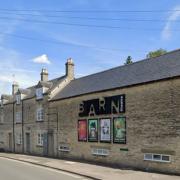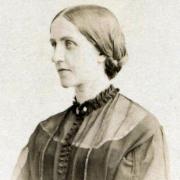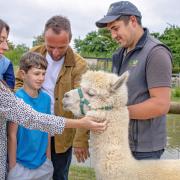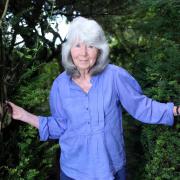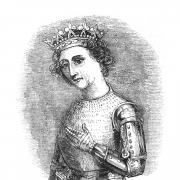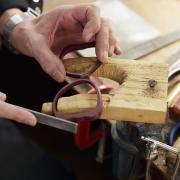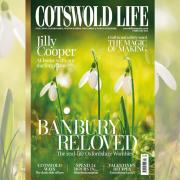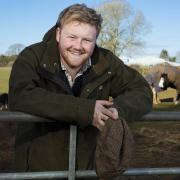This month sees the grand unveiling of Ebrington's parish boundary stones - the first to be erected in Gloucestershire for more than 100 years. Words by Katie Jarvis; photography by Antony Thompson
Rocks of ages
This month sees the grand unveiling of Ebrington’s parish boundary stones - the first to be erected in Gloucestershire for more than 100 years. Words by Katie Jarvis; photography by Antony Thompson
One hundred and fifty million years of history surround stone mason Matt Proctor, as he skilfully etches beautifully-formed letters into a giant block of stone. The rocks in North Cotswold quarry where he works are the legacy of the Jurassic Age: the era of the dinosaur. Mankind itself – never mind the alphabet – wasn’t even a concept when this golden-hued oolitic limestone was being formed.
History is part of the day-job for Matt. The tools he uses would be familiar to the craftsmen of the Dark Ages who shaped the stone for Berkeley Castle, or the medieval masons etching their marks on the blocks that now grace Gloucester Cathedral. “The only thing that’s changed over time is that, where they might have had a week to rough something out with hand-tools, we’ve got cutters,” Matt muses. “The actual finishing-off is the same.” But today, as Matt carefully forms the word ‘Ebrington’ on the one-and-a-half tonne, four-foot-high slab in front of him, he’s not following history; he’s creating it.
He’s part of an extraordinary project to erect the first parish boundary stones in Gloucestershire for more than 100 years: a project designed by the parish to mark the Diamond Jubilee of Queen Elizabeth II. There will be a stone at each of the boundaries where Ebrington meets its seven neighbouring parishes, plus a central information stone within the village, which will record, explain and map the scheme. Each will be carved with the appropriate place-names, as well as bearing the legend ‘EIIR 2012’. Some blocks have been chosen for their height: honey-coloured beacons on the horizon; others for their width: an invitation to picnickers to stop and sit or, indeed, to lay out their meal as on a table.
Tony Boyse is one of the five-strong project team who are visiting Oathill Quarry near Temple Guiting to see how things are taking shape. “The Diamond Jubilee is a very special occasion,” he says. “It’s only happened once before in the lifetime of monarchs, and none of us alive now is likely to see another one, so it’s unique. Everybody will be providing mugs for kids and suchlike, but we wanted to do something different. These stones will be here when we’re pushing up daisies. They’re a big statement; they fit in; they will look lovely.”
He and his wife, Jenny, own a B&B in the village; but it was while the couple were on holiday themselves – near Ringmore - that they came up with the idea. This Devonshire parish had erected its own stones to commemorate a local family. “They’d created a book of walks round them, and I thought it was a great idea.” When the Boyses returned home, they made the suggestion to the Ebrington Jubilee Committee that their parish should do something similar – and, thus, this North Cotswold neo-Stonehenge was born.
To say the idea has been greeted with enthusiasm is something of an understatement. There’s hardly a soul who hasn’t got involved. Whether it’s digging into pockets to help fund it, or lending a JCB to get the stones in place, the 650-or-so parishioners have come up trumps. Matt Proctor, who has a family history dating back 300 years in Ebrington, is giving his ‘carving’ time for free, and Oathill Quarry – owned by the Great Tew Estate - has supplied the stones. Quarry manager, Paul Keyte, also has family and social connections with the parish. “The stone we have is that beautiful honey-buff colour,” he says. “Every quarry will give it its own name but we call it gold and cream. It’s a totally different colour in its natural form on the quarry face, when it’s full of sap and natural moisture. But it dries to this gorgeous typical honey hue,” he says, pointing to the syrup-y slabs in front of us.
“You can see our stone all around – in Broadway and Chipping Campden, for example – and it’s even been shipped for projects in S�o Paulo and San Francisco. The Americans and the Japanese, particularly, love it. We often get taxi drivers coming to the quarry just to show it off to tourists: they’re so interested!”
They’re not the only ones. Children from Ebrington’s little village school will be using the project to learn about their Cotswold geology, as well as visiting Matt to see his work. Local historian Margaret Fisher, who has co-written three books on Ebrington, is one of the project team. Doubtless she’ll be advising the pupils on the time-capsule they’re creating to place under one of the stone. “This is very exciting for historians,” she says. “As far as I know, Ebrington has never had boundary stones before. We have some ancient stones, such as the ‘Hoar’, which we really know very little about.”
Future generations will have no such problems. The names of everyone who has contributed will be recorded; and the team is compiling a photo-book, from quarrying to positioning. The grand unveiling will be in Ebrington on June 2, when there’ll be guided walks and bus transportation from the village hall around the stones from 1.30pm, and the official opening – by Lord Lieutenant Dame Janet Trotter – at 4pm. Books of the walks will be locally available from June onwards.
But the point about this project is that it’s more than the sum of its parts. For the whole parish, this is a chance to carve an imprint on the future. For Matt, it’s a particularly special opportunity. “When I did my apprenticeship at masonry college in Bath, there were only 10 of us on the course – yet the demand for stone-masons’ skills is huge. Everyone goes to university nowadays; there aren’t many kids that do apprenticeships. In our trade, we struggle to find young kids who want to learn; but they need to know that there are ways to earn a good living other than an office environment.”
In other words, this is also a chance to spread the word about an age-old trade that still gives huge job satisfaction. “I’d like to know how they built the pyramids,” Matt says. “I’d like to go back to medieval times when they were building the castles; when masons would literally start a project and die on it. My job is about history and tradition.”
And if you want to know more, as they say, then visit Ebrington on June 2.
Anyone who would like to donate to the project – from an individual letter to a complete stone – should contact committee treasurer Gillian Wass on 01386 593782.The photograph shows stonemason Matt Procter with the completed Ebrington marker









